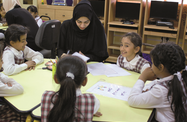RAK has seen a number of important developments in its education sector in recent years as the emirate continues its drive to become a knowledge-based economy. Most significant among these has been the decision to create a council to oversee and regulate the emirate’s growing number of colleges and universities.
Although the council – established by Sheikh Saud Bin Saqr Al Qasimi in 2011 – had yet to formally meet as of March 2012, the announcement of its formation is already having tangible effects, doing much to improve the education sector’s image. It is also making the emirate more attractive to foreign educational institutions, as the council will have the power to expel underperforming institutions and protect students from malpractice.
Furthermore, the emirate’s continued emphasis on the standard of education is encouraging opportunities for international partnerships. RAK is now finding recognition as a top destination for educational institutions. In early March, Indian education services provider, CORE Education, announced its decision to invest in a $2m academic learning centre in the RAK Free Trade Zone (RAK FTZ). The CORE International Institute of Higher Education will offer programmes in engineering, architecture and business administration, with additional plans to open a Master of Business Administration (MBA) course.
This development will add to RAK’s growing list of schools and universities, which include the Lausanne-based École Polytechnique Fédérale de Lausanne, the American University of RAK and a branch of the UK-based University of Bolton. Indeed, just 12 years ago RAK had one university; now it has 14, offering a wide range of academic and vocational subjects.
The emirate intends to build on this number and has aims to become a regional centre for education in the UAE. However, in order for interested parties to begin setting up in the emirate, the education council will first need to meet to establish clear guidelines for standards and quality assurance.
Previously, the absence of regulation and quality standards in RAK’s education sector was seen as a competitive edge in attracting foreign entrants. Yet while this policy may have had some benefits, it has come to be viewed as a limiting factor, with both institutions and students alike seeking increased quality control.
In line with its efforts to improve the standard of education, most notably through its long-term Education 2020 strategy – which promotes critical thinking in classrooms over the traditional rote learning method – the so-called “10x10” programme was launched in early 2010, and has taken the reforms a step further. The programme seeks to orientate education towards a career-centred goal, strengthen the bridge between new graduates and the labour market, and increase the employability of students by widening their range of skills.
Going forward, the government has identified two priorities for the sector: to raise the standard of teachers and to improve the quality of research in higher education. The task of delivering these objectives has been taken on by the Al Qasimi Foundation for Policy Research. In 2010 this educational think-tank launched the Teacher’s Network initiative, aimed at increasing interaction between teaching staff and students, and allowing teachers from across the UAE to come together to share resources, ideas and best practices. It was reported in mid-2011 that more than 175 teachers from various schools in RAK were active members of the site.
The Al Qasimi Foundation is also offering a number of research scholarships to encourage international doctoral students to undertake part of their study in RAK. The strategy aims to raise research standards at the tertiary level by bringing in cutting-edge academics and PhD students, who can win financial backing by either locating in RAK or by being affiliated with an institution from the emirate.
With international involvement in the sector set to rise, both in terms of institutions and academic personnel, RAK will likely continue to see higher educational standards – and sector competitiveness – over the coming years.

